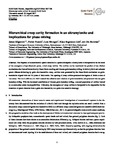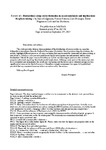Hierarchical creep cavity formation in an ultramylonite and implications for phase mixing
| dc.contributor.author | Gilgannon, J | en |
| dc.contributor.author | Fusseis, F | en |
| dc.contributor.author | Menegon, L | en |
| dc.contributor.author | Regenauer-Lieb, K | en |
| dc.contributor.author | Buckman, J | en |
| dc.date.accessioned | 2018-10-01T14:37:11Z | |
| dc.date.available | 2018-10-01T14:37:11Z | |
| dc.date.issued | 2017-12-19 | en |
| dc.identifier.issn | 1869-9510 | en |
| dc.identifier.uri | http://hdl.handle.net/10026.1/12439 | |
| dc.description.abstract |
Establishing models for the formation of well-mixed polyphase domains in ultramylonites is difficult because the effects of large strains and thermo-hydro-chemo-mechanical feedbacks can obscure the transient phenomena that may be responsible for domain production. We use scanning electron microscopy and nanotomography to offer critical insights into how the microstructure of a highly deformed quartzo-feldspathic ultramylonite evolved. The dispersal of monomineralic quartz domains in the ultramylonite is interpreted to be the result of the emergence of synkinematic pores, called creep cavities. The cavities can be considered the product of two distinct mechanisms that formed hierarchically: Zener-Stroh cracking and viscous grain-boundary sliding. In initially thick and coherent quartz ribbons deforming by grain-size-insensitive creep, cavities were generated by the Zener-Stroh mechanism on grain boundaries aligned with the | en |
| dc.format.extent | 1193 - 1209 | en |
| dc.language.iso | en | en |
| dc.title | Hierarchical creep cavity formation in an ultramylonite and implications for phase mixing | en |
| dc.type | Journal Article | |
| plymouth.issue | 6 | en |
| plymouth.volume | 8 | en |
| plymouth.publication-status | Published | en |
| plymouth.journal | Solid Earth | en |
| dc.identifier.doi | 10.5194/se-8-1193-2017 | en |
| plymouth.organisational-group | /Plymouth | |
| plymouth.organisational-group | /Plymouth/Faculty of Science and Engineering | |
| plymouth.organisational-group | /Plymouth/REF 2021 Researchers by UoA | |
| plymouth.organisational-group | /Plymouth/REF 2021 Researchers by UoA/UoA07 Earth Systems and Environmental Sciences | |
| dc.identifier.eissn | 1869-9529 | en |
| dc.rights.embargoperiod | Not known | en |
| rioxxterms.versionofrecord | 10.5194/se-8-1193-2017 | en |
| rioxxterms.licenseref.uri | http://www.rioxx.net/licenses/all-rights-reserved | en |
| rioxxterms.type | Journal Article/Review | en |



